BULAW5914 Business Law Assignment: Australian Consumer Law and Torts
VerifiedAdded on 2023/06/05
|13
|3506
|420
Homework Assignment
AI Summary
This assignment analyzes consumer rights under Australian Consumer Law (ACL) and tort law, focusing on manufacturer and seller liabilities. The first question compares consumer rights under ACL and tort law, examining the case of Ann who fell ill after consuming expired salami. It explores the manufacturer's and supermarket's liabilities, including the application of defenses like contributory negligence. The second question delves into Shanti's rights against U-Best Shoes Factory under tort law, considering the duty of care and principles from Caparo Industries PLC v Dickman. The assignment highlights the importance of providing defect-free goods, the limitations of seller liability, and the impact of consumer negligence. It concludes with the potential liabilities of Smallgoods Pty Ltd and Supermarkets Pty. Ltd, emphasizing the nuances of legal defenses and consumer protection.
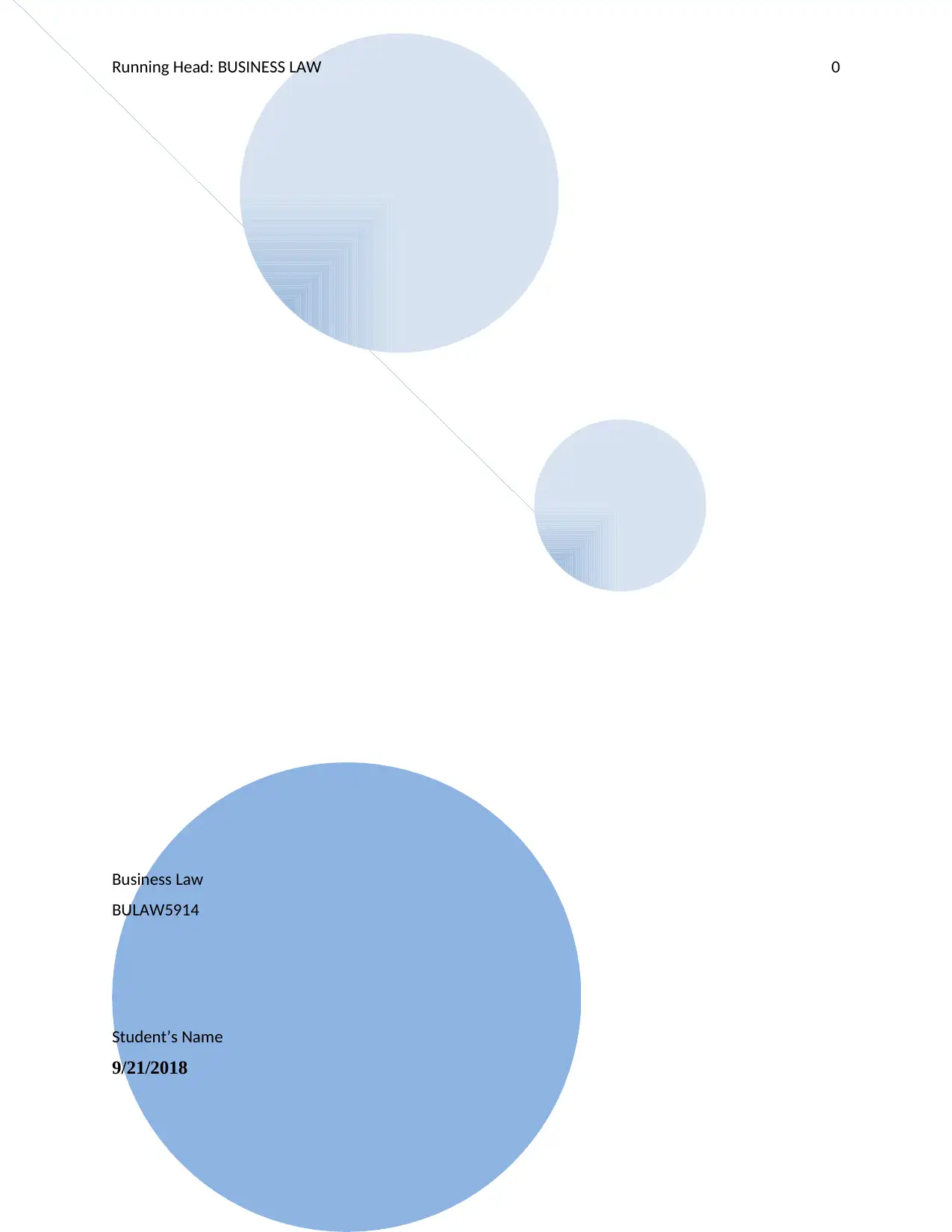
Running Head: BUSINESS LAW 0
Business Law
BULAW5914
Student’s Name
9/21/2018
Business Law
BULAW5914
Student’s Name
9/21/2018
Paraphrase This Document
Need a fresh take? Get an instant paraphrase of this document with our AI Paraphraser
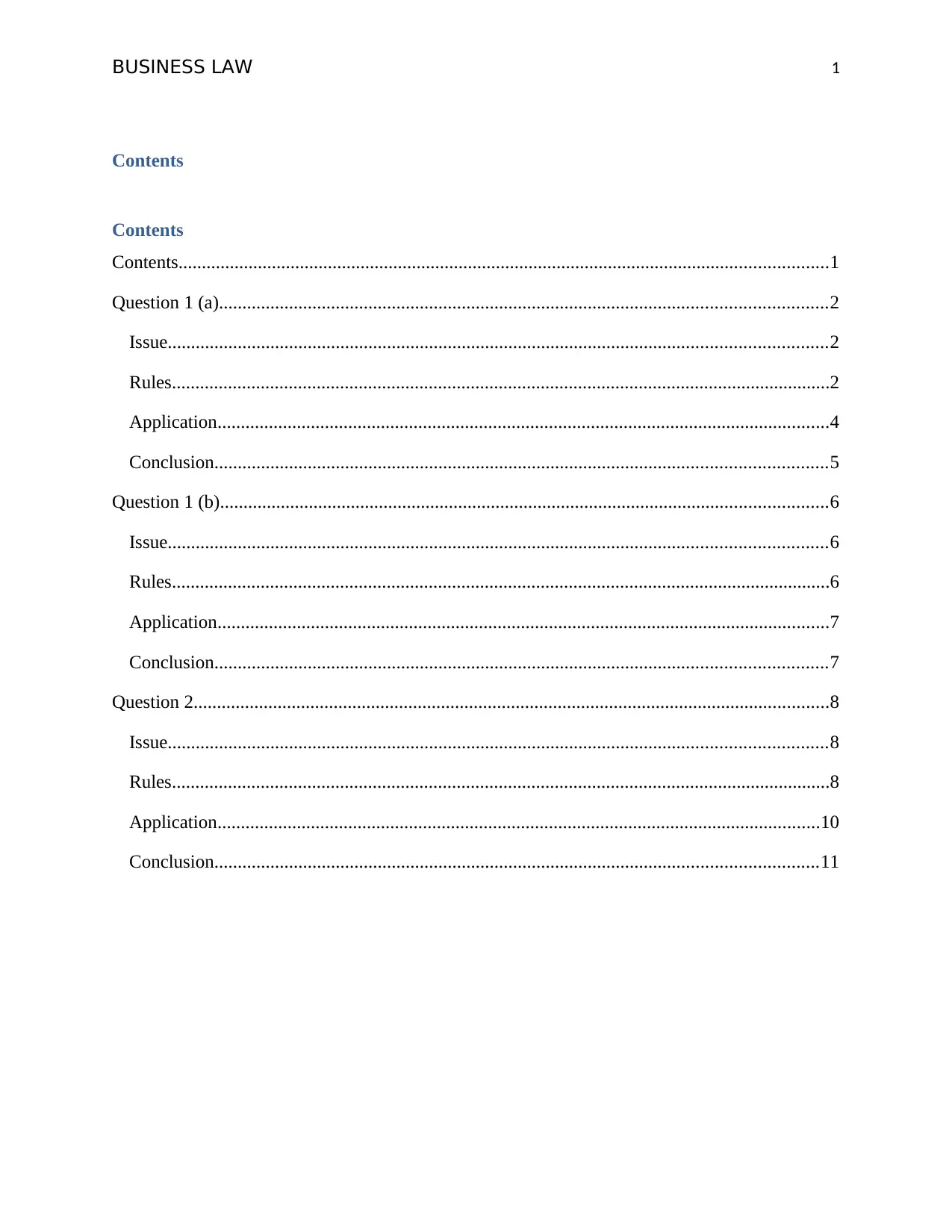
BUSINESS LAW 1
Contents
Contents
Contents...........................................................................................................................................1
Question 1 (a)..................................................................................................................................2
Issue.............................................................................................................................................2
Rules.............................................................................................................................................2
Application...................................................................................................................................4
Conclusion...................................................................................................................................5
Question 1 (b)..................................................................................................................................6
Issue.............................................................................................................................................6
Rules.............................................................................................................................................6
Application...................................................................................................................................7
Conclusion...................................................................................................................................7
Question 2........................................................................................................................................8
Issue.............................................................................................................................................8
Rules.............................................................................................................................................8
Application.................................................................................................................................10
Conclusion.................................................................................................................................11
Contents
Contents
Contents...........................................................................................................................................1
Question 1 (a)..................................................................................................................................2
Issue.............................................................................................................................................2
Rules.............................................................................................................................................2
Application...................................................................................................................................4
Conclusion...................................................................................................................................5
Question 1 (b)..................................................................................................................................6
Issue.............................................................................................................................................6
Rules.............................................................................................................................................6
Application...................................................................................................................................7
Conclusion...................................................................................................................................7
Question 2........................................................................................................................................8
Issue.............................................................................................................................................8
Rules.............................................................................................................................................8
Application.................................................................................................................................10
Conclusion.................................................................................................................................11
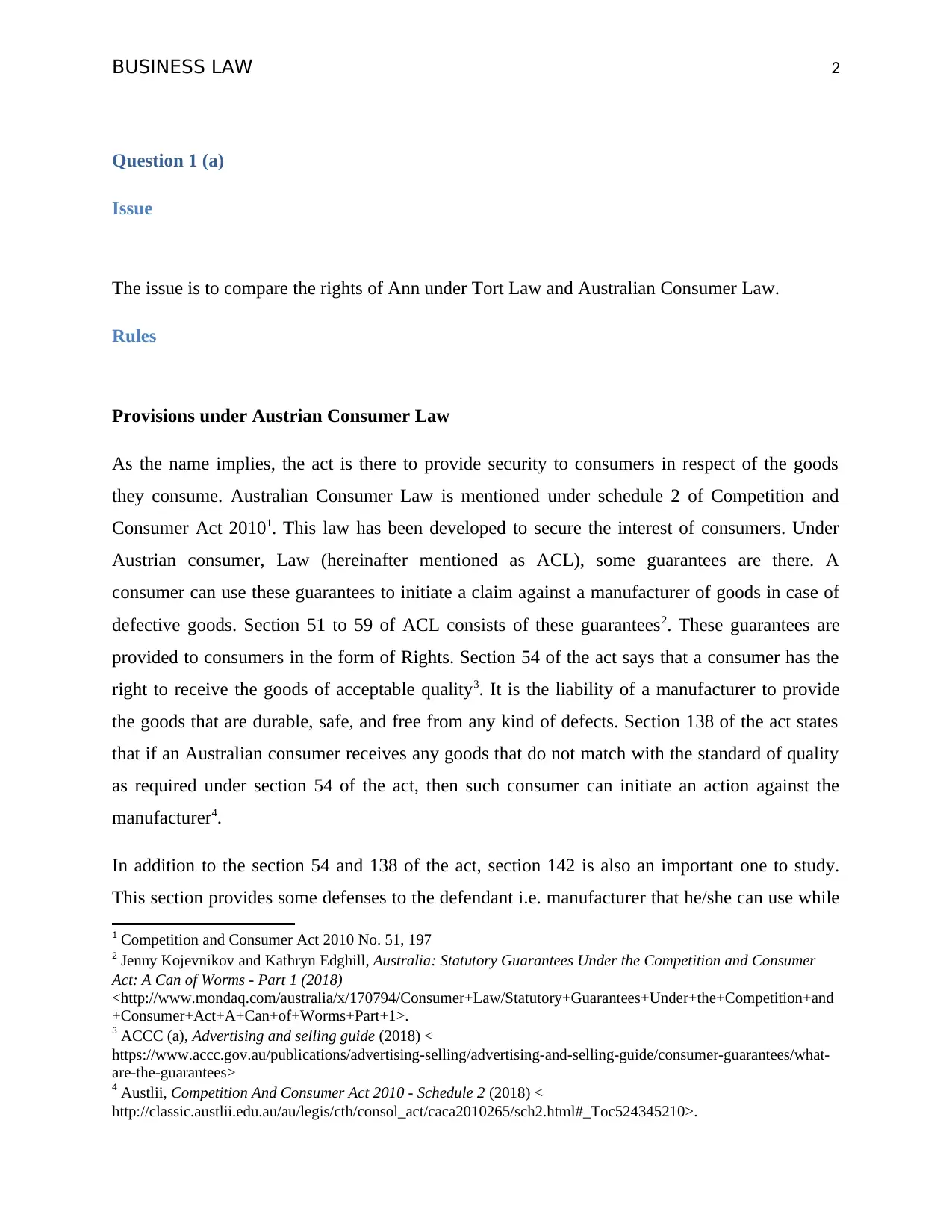
BUSINESS LAW 2
Question 1 (a)
Issue
The issue is to compare the rights of Ann under Tort Law and Australian Consumer Law.
Rules
Provisions under Austrian Consumer Law
As the name implies, the act is there to provide security to consumers in respect of the goods
they consume. Australian Consumer Law is mentioned under schedule 2 of Competition and
Consumer Act 20101. This law has been developed to secure the interest of consumers. Under
Austrian consumer, Law (hereinafter mentioned as ACL), some guarantees are there. A
consumer can use these guarantees to initiate a claim against a manufacturer of goods in case of
defective goods. Section 51 to 59 of ACL consists of these guarantees2. These guarantees are
provided to consumers in the form of Rights. Section 54 of the act says that a consumer has the
right to receive the goods of acceptable quality3. It is the liability of a manufacturer to provide
the goods that are durable, safe, and free from any kind of defects. Section 138 of the act states
that if an Australian consumer receives any goods that do not match with the standard of quality
as required under section 54 of the act, then such consumer can initiate an action against the
manufacturer4.
In addition to the section 54 and 138 of the act, section 142 is also an important one to study.
This section provides some defenses to the defendant i.e. manufacturer that he/she can use while
1 Competition and Consumer Act 2010 No. 51, 197
2 Jenny Kojevnikov and Kathryn Edghill, Australia: Statutory Guarantees Under the Competition and Consumer
Act: A Can of Worms - Part 1 (2018)
<http://www.mondaq.com/australia/x/170794/Consumer+Law/Statutory+Guarantees+Under+the+Competition+and
+Consumer+Act+A+Can+of+Worms+Part+1>.
3 ACCC (a), Advertising and selling guide (2018) <
https://www.accc.gov.au/publications/advertising-selling/advertising-and-selling-guide/consumer-guarantees/what-
are-the-guarantees>
4 Austlii, Competition And Consumer Act 2010 - Schedule 2 (2018) <
http://classic.austlii.edu.au/au/legis/cth/consol_act/caca2010265/sch2.html#_Toc524345210>.
Question 1 (a)
Issue
The issue is to compare the rights of Ann under Tort Law and Australian Consumer Law.
Rules
Provisions under Austrian Consumer Law
As the name implies, the act is there to provide security to consumers in respect of the goods
they consume. Australian Consumer Law is mentioned under schedule 2 of Competition and
Consumer Act 20101. This law has been developed to secure the interest of consumers. Under
Austrian consumer, Law (hereinafter mentioned as ACL), some guarantees are there. A
consumer can use these guarantees to initiate a claim against a manufacturer of goods in case of
defective goods. Section 51 to 59 of ACL consists of these guarantees2. These guarantees are
provided to consumers in the form of Rights. Section 54 of the act says that a consumer has the
right to receive the goods of acceptable quality3. It is the liability of a manufacturer to provide
the goods that are durable, safe, and free from any kind of defects. Section 138 of the act states
that if an Australian consumer receives any goods that do not match with the standard of quality
as required under section 54 of the act, then such consumer can initiate an action against the
manufacturer4.
In addition to the section 54 and 138 of the act, section 142 is also an important one to study.
This section provides some defenses to the defendant i.e. manufacturer that he/she can use while
1 Competition and Consumer Act 2010 No. 51, 197
2 Jenny Kojevnikov and Kathryn Edghill, Australia: Statutory Guarantees Under the Competition and Consumer
Act: A Can of Worms - Part 1 (2018)
<http://www.mondaq.com/australia/x/170794/Consumer+Law/Statutory+Guarantees+Under+the+Competition+and
+Consumer+Act+A+Can+of+Worms+Part+1>.
3 ACCC (a), Advertising and selling guide (2018) <
https://www.accc.gov.au/publications/advertising-selling/advertising-and-selling-guide/consumer-guarantees/what-
are-the-guarantees>
4 Austlii, Competition And Consumer Act 2010 - Schedule 2 (2018) <
http://classic.austlii.edu.au/au/legis/cth/consol_act/caca2010265/sch2.html#_Toc524345210>.
⊘ This is a preview!⊘
Do you want full access?
Subscribe today to unlock all pages.

Trusted by 1+ million students worldwide
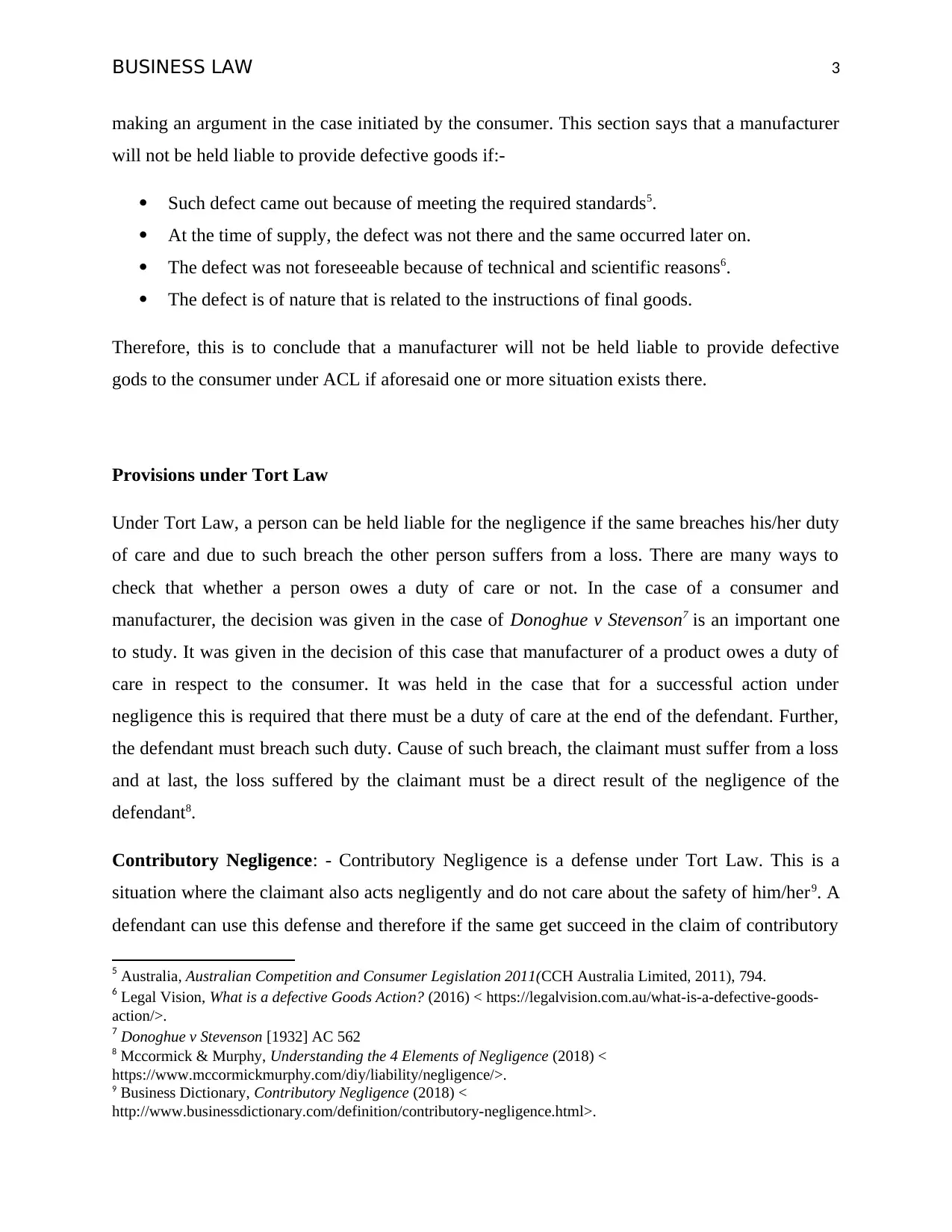
BUSINESS LAW 3
making an argument in the case initiated by the consumer. This section says that a manufacturer
will not be held liable to provide defective goods if:-
Such defect came out because of meeting the required standards5.
At the time of supply, the defect was not there and the same occurred later on.
The defect was not foreseeable because of technical and scientific reasons6.
The defect is of nature that is related to the instructions of final goods.
Therefore, this is to conclude that a manufacturer will not be held liable to provide defective
gods to the consumer under ACL if aforesaid one or more situation exists there.
Provisions under Tort Law
Under Tort Law, a person can be held liable for the negligence if the same breaches his/her duty
of care and due to such breach the other person suffers from a loss. There are many ways to
check that whether a person owes a duty of care or not. In the case of a consumer and
manufacturer, the decision was given in the case of Donoghue v Stevenson7 is an important one
to study. It was given in the decision of this case that manufacturer of a product owes a duty of
care in respect to the consumer. It was held in the case that for a successful action under
negligence this is required that there must be a duty of care at the end of the defendant. Further,
the defendant must breach such duty. Cause of such breach, the claimant must suffer from a loss
and at last, the loss suffered by the claimant must be a direct result of the negligence of the
defendant8.
Contributory Negligence: - Contributory Negligence is a defense under Tort Law. This is a
situation where the claimant also acts negligently and do not care about the safety of him/her9. A
defendant can use this defense and therefore if the same get succeed in the claim of contributory
5 Australia, Australian Competition and Consumer Legislation 2011(CCH Australia Limited, 2011), 794.
6 Legal Vision, What is a defective Goods Action? (2016) < https://legalvision.com.au/what-is-a-defective-goods-
action/>.
7 Donoghue v Stevenson [1932] AC 562
8 Mccormick & Murphy, Understanding the 4 Elements of Negligence (2018) <
https://www.mccormickmurphy.com/diy/liability/negligence/>.
9 Business Dictionary, Contributory Negligence (2018) <
http://www.businessdictionary.com/definition/contributory-negligence.html>.
making an argument in the case initiated by the consumer. This section says that a manufacturer
will not be held liable to provide defective goods if:-
Such defect came out because of meeting the required standards5.
At the time of supply, the defect was not there and the same occurred later on.
The defect was not foreseeable because of technical and scientific reasons6.
The defect is of nature that is related to the instructions of final goods.
Therefore, this is to conclude that a manufacturer will not be held liable to provide defective
gods to the consumer under ACL if aforesaid one or more situation exists there.
Provisions under Tort Law
Under Tort Law, a person can be held liable for the negligence if the same breaches his/her duty
of care and due to such breach the other person suffers from a loss. There are many ways to
check that whether a person owes a duty of care or not. In the case of a consumer and
manufacturer, the decision was given in the case of Donoghue v Stevenson7 is an important one
to study. It was given in the decision of this case that manufacturer of a product owes a duty of
care in respect to the consumer. It was held in the case that for a successful action under
negligence this is required that there must be a duty of care at the end of the defendant. Further,
the defendant must breach such duty. Cause of such breach, the claimant must suffer from a loss
and at last, the loss suffered by the claimant must be a direct result of the negligence of the
defendant8.
Contributory Negligence: - Contributory Negligence is a defense under Tort Law. This is a
situation where the claimant also acts negligently and do not care about the safety of him/her9. A
defendant can use this defense and therefore if the same get succeed in the claim of contributory
5 Australia, Australian Competition and Consumer Legislation 2011(CCH Australia Limited, 2011), 794.
6 Legal Vision, What is a defective Goods Action? (2016) < https://legalvision.com.au/what-is-a-defective-goods-
action/>.
7 Donoghue v Stevenson [1932] AC 562
8 Mccormick & Murphy, Understanding the 4 Elements of Negligence (2018) <
https://www.mccormickmurphy.com/diy/liability/negligence/>.
9 Business Dictionary, Contributory Negligence (2018) <
http://www.businessdictionary.com/definition/contributory-negligence.html>.
Paraphrase This Document
Need a fresh take? Get an instant paraphrase of this document with our AI Paraphraser
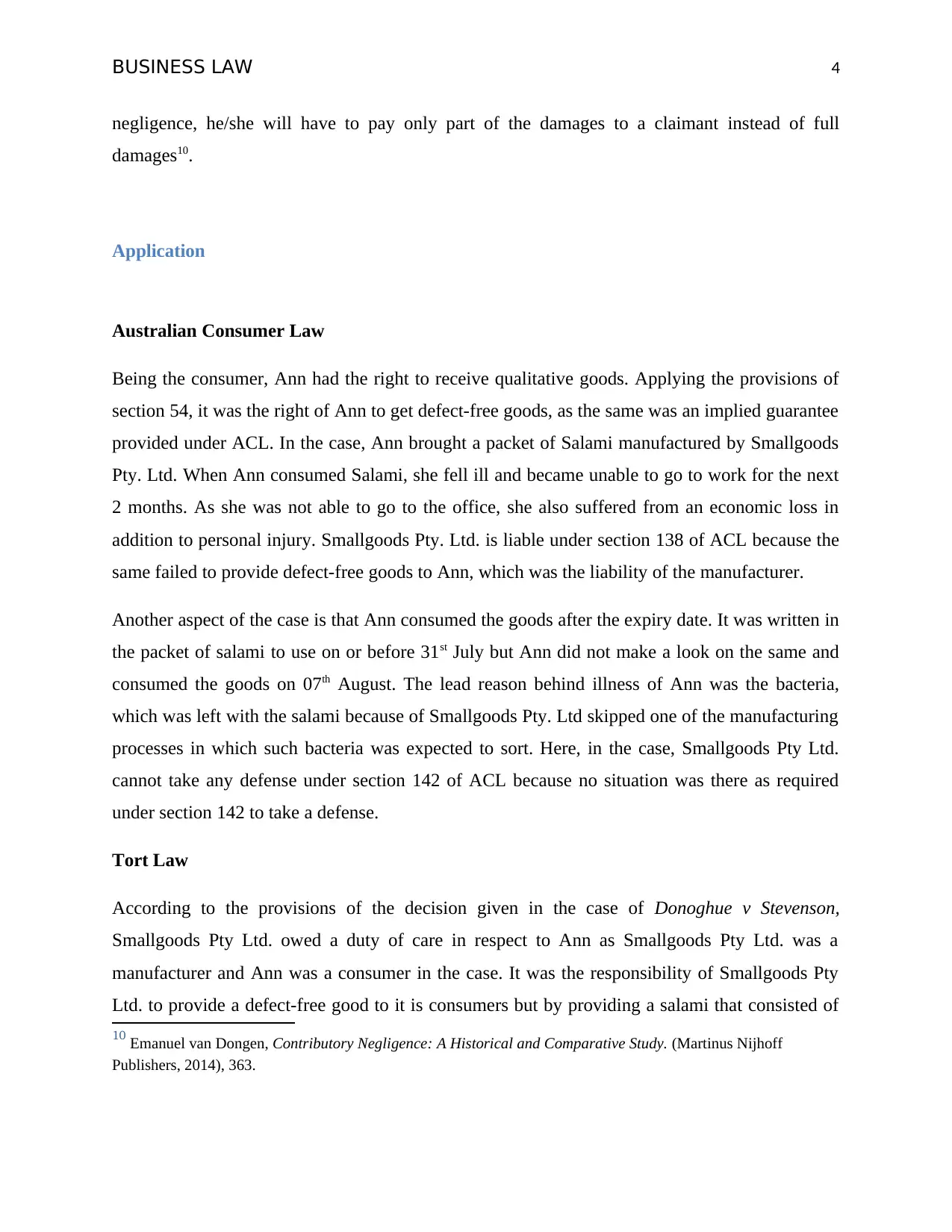
BUSINESS LAW 4
negligence, he/she will have to pay only part of the damages to a claimant instead of full
damages10.
Application
Australian Consumer Law
Being the consumer, Ann had the right to receive qualitative goods. Applying the provisions of
section 54, it was the right of Ann to get defect-free goods, as the same was an implied guarantee
provided under ACL. In the case, Ann brought a packet of Salami manufactured by Smallgoods
Pty. Ltd. When Ann consumed Salami, she fell ill and became unable to go to work for the next
2 months. As she was not able to go to the office, she also suffered from an economic loss in
addition to personal injury. Smallgoods Pty. Ltd. is liable under section 138 of ACL because the
same failed to provide defect-free goods to Ann, which was the liability of the manufacturer.
Another aspect of the case is that Ann consumed the goods after the expiry date. It was written in
the packet of salami to use on or before 31st July but Ann did not make a look on the same and
consumed the goods on 07th August. The lead reason behind illness of Ann was the bacteria,
which was left with the salami because of Smallgoods Pty. Ltd skipped one of the manufacturing
processes in which such bacteria was expected to sort. Here, in the case, Smallgoods Pty Ltd.
cannot take any defense under section 142 of ACL because no situation was there as required
under section 142 to take a defense.
Tort Law
According to the provisions of the decision given in the case of Donoghue v Stevenson,
Smallgoods Pty Ltd. owed a duty of care in respect to Ann as Smallgoods Pty Ltd. was a
manufacturer and Ann was a consumer in the case. It was the responsibility of Smallgoods Pty
Ltd. to provide a defect-free good to it is consumers but by providing a salami that consisted of
10 Emanuel van Dongen, Contributory Negligence: A Historical and Comparative Study. (Martinus Nijhoff
Publishers, 2014), 363.
negligence, he/she will have to pay only part of the damages to a claimant instead of full
damages10.
Application
Australian Consumer Law
Being the consumer, Ann had the right to receive qualitative goods. Applying the provisions of
section 54, it was the right of Ann to get defect-free goods, as the same was an implied guarantee
provided under ACL. In the case, Ann brought a packet of Salami manufactured by Smallgoods
Pty. Ltd. When Ann consumed Salami, she fell ill and became unable to go to work for the next
2 months. As she was not able to go to the office, she also suffered from an economic loss in
addition to personal injury. Smallgoods Pty. Ltd. is liable under section 138 of ACL because the
same failed to provide defect-free goods to Ann, which was the liability of the manufacturer.
Another aspect of the case is that Ann consumed the goods after the expiry date. It was written in
the packet of salami to use on or before 31st July but Ann did not make a look on the same and
consumed the goods on 07th August. The lead reason behind illness of Ann was the bacteria,
which was left with the salami because of Smallgoods Pty. Ltd skipped one of the manufacturing
processes in which such bacteria was expected to sort. Here, in the case, Smallgoods Pty Ltd.
cannot take any defense under section 142 of ACL because no situation was there as required
under section 142 to take a defense.
Tort Law
According to the provisions of the decision given in the case of Donoghue v Stevenson,
Smallgoods Pty Ltd. owed a duty of care in respect to Ann as Smallgoods Pty Ltd. was a
manufacturer and Ann was a consumer in the case. It was the responsibility of Smallgoods Pty
Ltd. to provide a defect-free good to it is consumers but by providing a salami that consisted of
10 Emanuel van Dongen, Contributory Negligence: A Historical and Comparative Study. (Martinus Nijhoff
Publishers, 2014), 363.
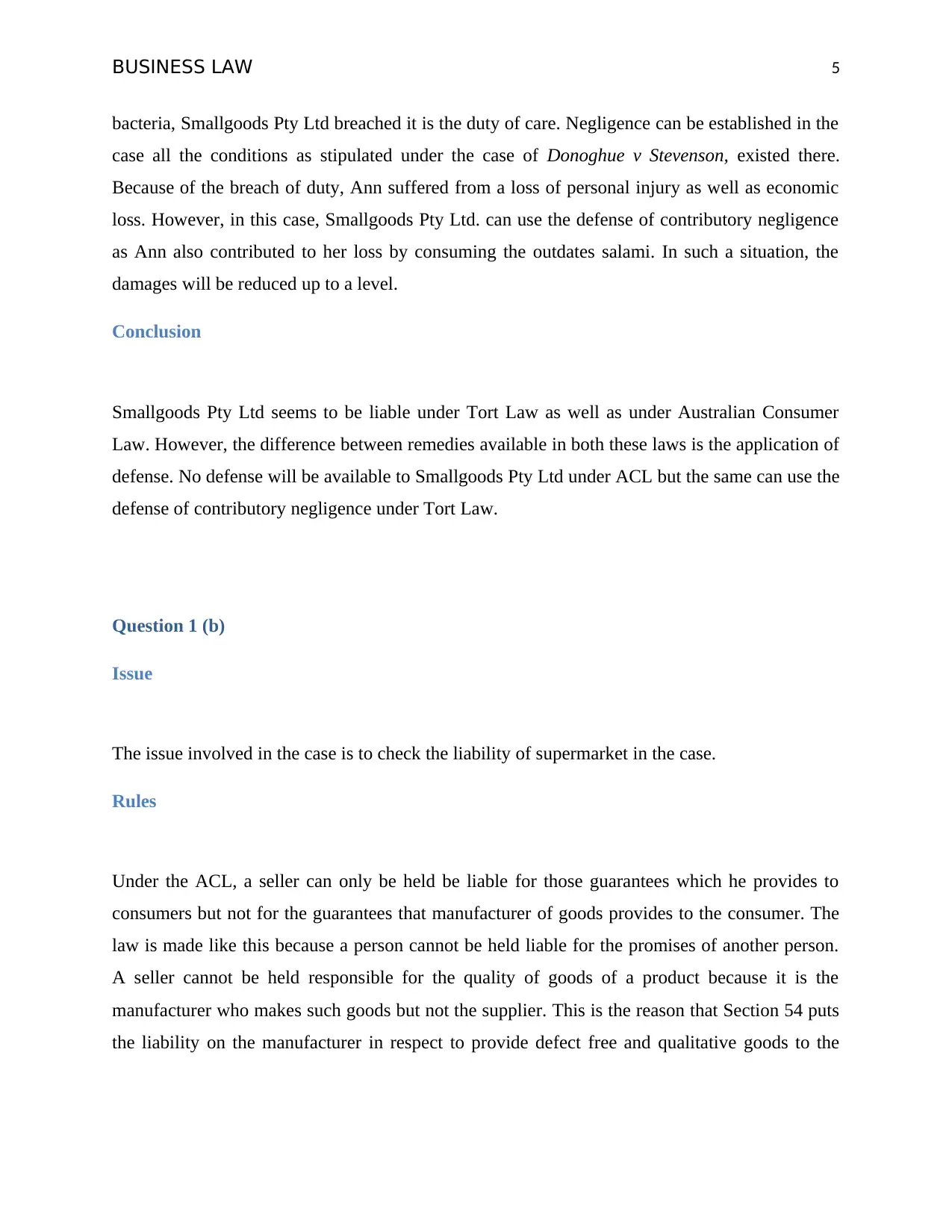
BUSINESS LAW 5
bacteria, Smallgoods Pty Ltd breached it is the duty of care. Negligence can be established in the
case all the conditions as stipulated under the case of Donoghue v Stevenson, existed there.
Because of the breach of duty, Ann suffered from a loss of personal injury as well as economic
loss. However, in this case, Smallgoods Pty Ltd. can use the defense of contributory negligence
as Ann also contributed to her loss by consuming the outdates salami. In such a situation, the
damages will be reduced up to a level.
Conclusion
Smallgoods Pty Ltd seems to be liable under Tort Law as well as under Australian Consumer
Law. However, the difference between remedies available in both these laws is the application of
defense. No defense will be available to Smallgoods Pty Ltd under ACL but the same can use the
defense of contributory negligence under Tort Law.
Question 1 (b)
Issue
The issue involved in the case is to check the liability of supermarket in the case.
Rules
Under the ACL, a seller can only be held be liable for those guarantees which he provides to
consumers but not for the guarantees that manufacturer of goods provides to the consumer. The
law is made like this because a person cannot be held liable for the promises of another person.
A seller cannot be held responsible for the quality of goods of a product because it is the
manufacturer who makes such goods but not the supplier. This is the reason that Section 54 puts
the liability on the manufacturer in respect to provide defect free and qualitative goods to the
bacteria, Smallgoods Pty Ltd breached it is the duty of care. Negligence can be established in the
case all the conditions as stipulated under the case of Donoghue v Stevenson, existed there.
Because of the breach of duty, Ann suffered from a loss of personal injury as well as economic
loss. However, in this case, Smallgoods Pty Ltd. can use the defense of contributory negligence
as Ann also contributed to her loss by consuming the outdates salami. In such a situation, the
damages will be reduced up to a level.
Conclusion
Smallgoods Pty Ltd seems to be liable under Tort Law as well as under Australian Consumer
Law. However, the difference between remedies available in both these laws is the application of
defense. No defense will be available to Smallgoods Pty Ltd under ACL but the same can use the
defense of contributory negligence under Tort Law.
Question 1 (b)
Issue
The issue involved in the case is to check the liability of supermarket in the case.
Rules
Under the ACL, a seller can only be held be liable for those guarantees which he provides to
consumers but not for the guarantees that manufacturer of goods provides to the consumer. The
law is made like this because a person cannot be held liable for the promises of another person.
A seller cannot be held responsible for the quality of goods of a product because it is the
manufacturer who makes such goods but not the supplier. This is the reason that Section 54 puts
the liability on the manufacturer in respect to provide defect free and qualitative goods to the
⊘ This is a preview!⊘
Do you want full access?
Subscribe today to unlock all pages.

Trusted by 1+ million students worldwide
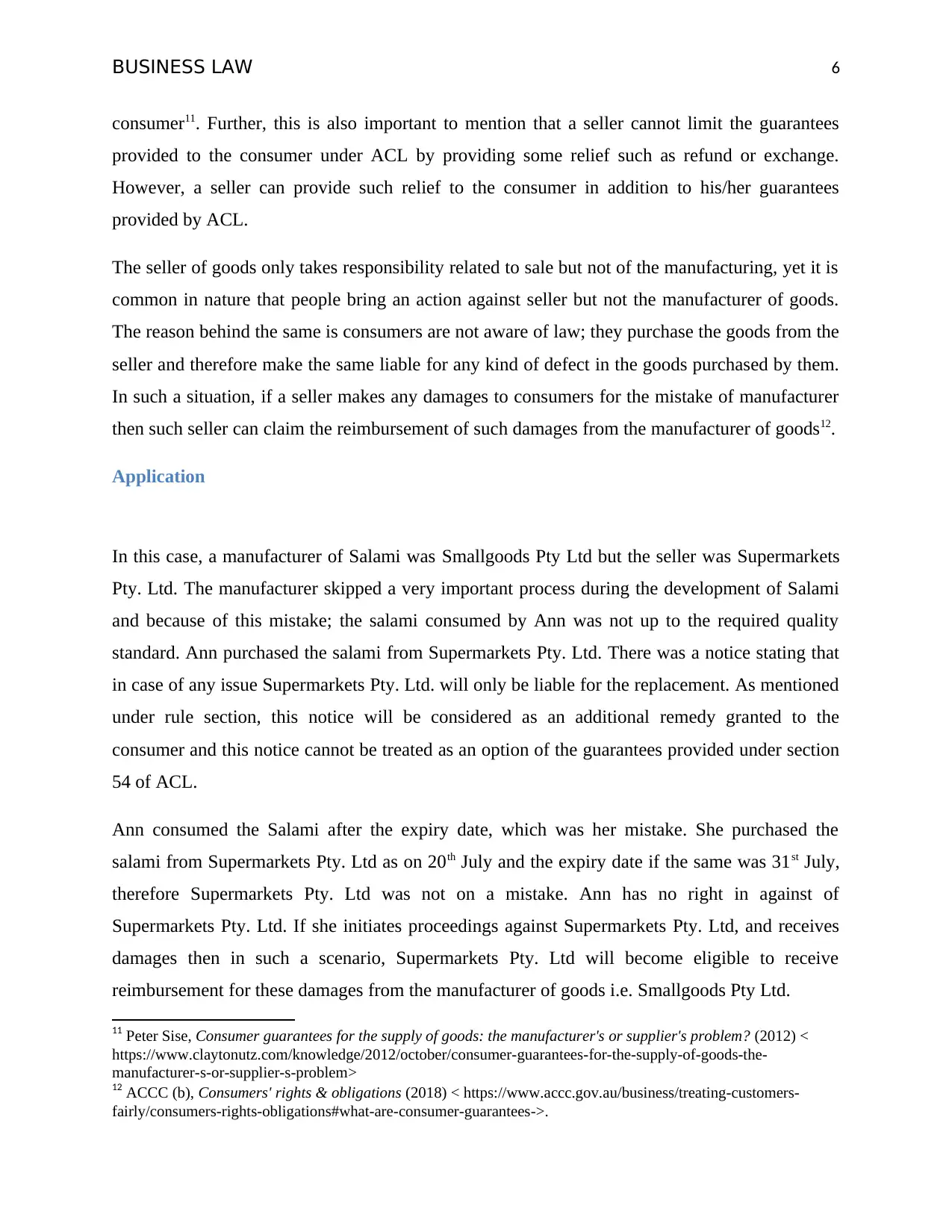
BUSINESS LAW 6
consumer11. Further, this is also important to mention that a seller cannot limit the guarantees
provided to the consumer under ACL by providing some relief such as refund or exchange.
However, a seller can provide such relief to the consumer in addition to his/her guarantees
provided by ACL.
The seller of goods only takes responsibility related to sale but not of the manufacturing, yet it is
common in nature that people bring an action against seller but not the manufacturer of goods.
The reason behind the same is consumers are not aware of law; they purchase the goods from the
seller and therefore make the same liable for any kind of defect in the goods purchased by them.
In such a situation, if a seller makes any damages to consumers for the mistake of manufacturer
then such seller can claim the reimbursement of such damages from the manufacturer of goods12.
Application
In this case, a manufacturer of Salami was Smallgoods Pty Ltd but the seller was Supermarkets
Pty. Ltd. The manufacturer skipped a very important process during the development of Salami
and because of this mistake; the salami consumed by Ann was not up to the required quality
standard. Ann purchased the salami from Supermarkets Pty. Ltd. There was a notice stating that
in case of any issue Supermarkets Pty. Ltd. will only be liable for the replacement. As mentioned
under rule section, this notice will be considered as an additional remedy granted to the
consumer and this notice cannot be treated as an option of the guarantees provided under section
54 of ACL.
Ann consumed the Salami after the expiry date, which was her mistake. She purchased the
salami from Supermarkets Pty. Ltd as on 20th July and the expiry date if the same was 31st July,
therefore Supermarkets Pty. Ltd was not on a mistake. Ann has no right in against of
Supermarkets Pty. Ltd. If she initiates proceedings against Supermarkets Pty. Ltd, and receives
damages then in such a scenario, Supermarkets Pty. Ltd will become eligible to receive
reimbursement for these damages from the manufacturer of goods i.e. Smallgoods Pty Ltd.
11 Peter Sise, Consumer guarantees for the supply of goods: the manufacturer's or supplier's problem? (2012) <
https://www.claytonutz.com/knowledge/2012/october/consumer-guarantees-for-the-supply-of-goods-the-
manufacturer-s-or-supplier-s-problem>
12 ACCC (b), Consumers' rights & obligations (2018) < https://www.accc.gov.au/business/treating-customers-
fairly/consumers-rights-obligations#what-are-consumer-guarantees->.
consumer11. Further, this is also important to mention that a seller cannot limit the guarantees
provided to the consumer under ACL by providing some relief such as refund or exchange.
However, a seller can provide such relief to the consumer in addition to his/her guarantees
provided by ACL.
The seller of goods only takes responsibility related to sale but not of the manufacturing, yet it is
common in nature that people bring an action against seller but not the manufacturer of goods.
The reason behind the same is consumers are not aware of law; they purchase the goods from the
seller and therefore make the same liable for any kind of defect in the goods purchased by them.
In such a situation, if a seller makes any damages to consumers for the mistake of manufacturer
then such seller can claim the reimbursement of such damages from the manufacturer of goods12.
Application
In this case, a manufacturer of Salami was Smallgoods Pty Ltd but the seller was Supermarkets
Pty. Ltd. The manufacturer skipped a very important process during the development of Salami
and because of this mistake; the salami consumed by Ann was not up to the required quality
standard. Ann purchased the salami from Supermarkets Pty. Ltd. There was a notice stating that
in case of any issue Supermarkets Pty. Ltd. will only be liable for the replacement. As mentioned
under rule section, this notice will be considered as an additional remedy granted to the
consumer and this notice cannot be treated as an option of the guarantees provided under section
54 of ACL.
Ann consumed the Salami after the expiry date, which was her mistake. She purchased the
salami from Supermarkets Pty. Ltd as on 20th July and the expiry date if the same was 31st July,
therefore Supermarkets Pty. Ltd was not on a mistake. Ann has no right in against of
Supermarkets Pty. Ltd. If she initiates proceedings against Supermarkets Pty. Ltd, and receives
damages then in such a scenario, Supermarkets Pty. Ltd will become eligible to receive
reimbursement for these damages from the manufacturer of goods i.e. Smallgoods Pty Ltd.
11 Peter Sise, Consumer guarantees for the supply of goods: the manufacturer's or supplier's problem? (2012) <
https://www.claytonutz.com/knowledge/2012/october/consumer-guarantees-for-the-supply-of-goods-the-
manufacturer-s-or-supplier-s-problem>
12 ACCC (b), Consumers' rights & obligations (2018) < https://www.accc.gov.au/business/treating-customers-
fairly/consumers-rights-obligations#what-are-consumer-guarantees->.
Paraphrase This Document
Need a fresh take? Get an instant paraphrase of this document with our AI Paraphraser
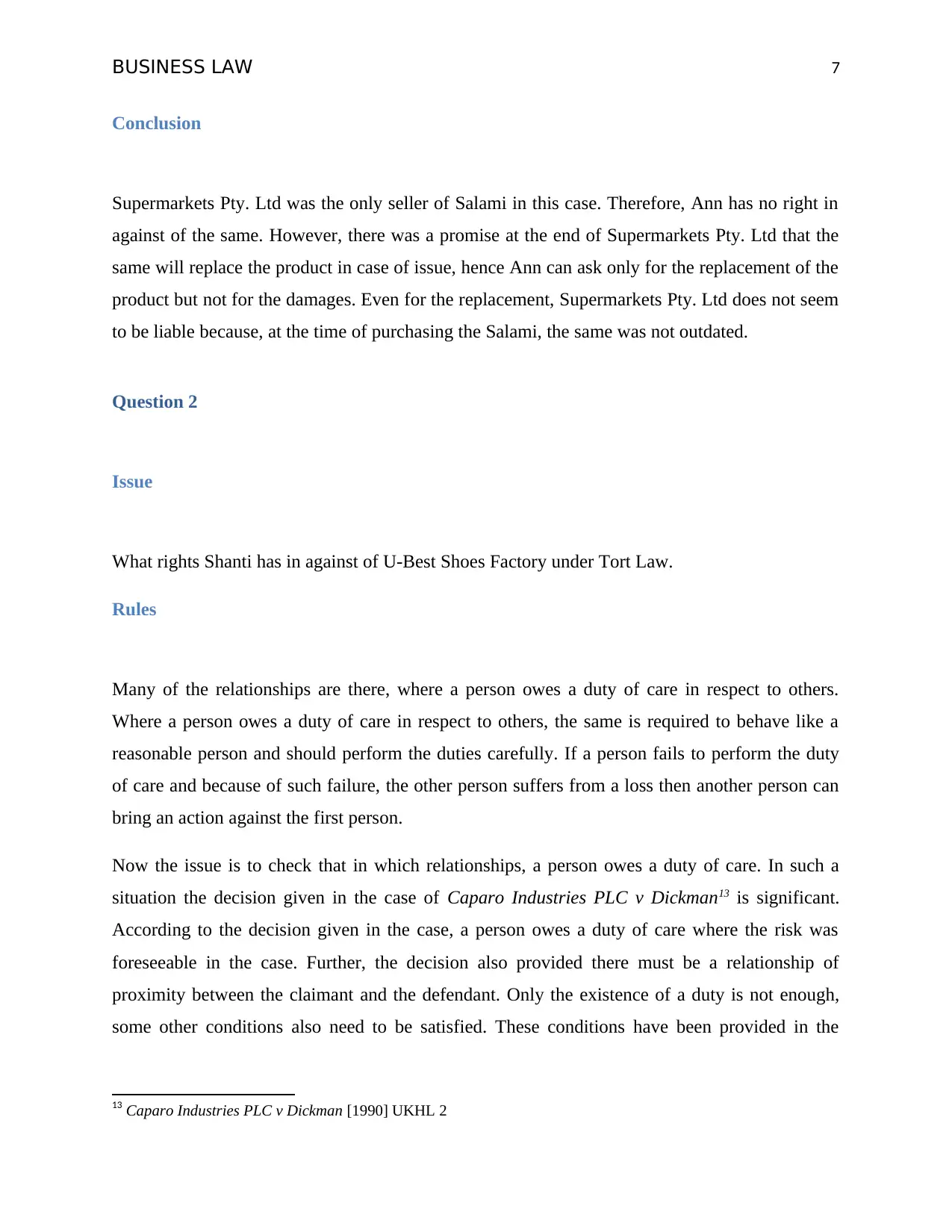
BUSINESS LAW 7
Conclusion
Supermarkets Pty. Ltd was the only seller of Salami in this case. Therefore, Ann has no right in
against of the same. However, there was a promise at the end of Supermarkets Pty. Ltd that the
same will replace the product in case of issue, hence Ann can ask only for the replacement of the
product but not for the damages. Even for the replacement, Supermarkets Pty. Ltd does not seem
to be liable because, at the time of purchasing the Salami, the same was not outdated.
Question 2
Issue
What rights Shanti has in against of U-Best Shoes Factory under Tort Law.
Rules
Many of the relationships are there, where a person owes a duty of care in respect to others.
Where a person owes a duty of care in respect to others, the same is required to behave like a
reasonable person and should perform the duties carefully. If a person fails to perform the duty
of care and because of such failure, the other person suffers from a loss then another person can
bring an action against the first person.
Now the issue is to check that in which relationships, a person owes a duty of care. In such a
situation the decision given in the case of Caparo Industries PLC v Dickman13 is significant.
According to the decision given in the case, a person owes a duty of care where the risk was
foreseeable in the case. Further, the decision also provided there must be a relationship of
proximity between the claimant and the defendant. Only the existence of a duty is not enough,
some other conditions also need to be satisfied. These conditions have been provided in the
13 Caparo Industries PLC v Dickman [1990] UKHL 2
Conclusion
Supermarkets Pty. Ltd was the only seller of Salami in this case. Therefore, Ann has no right in
against of the same. However, there was a promise at the end of Supermarkets Pty. Ltd that the
same will replace the product in case of issue, hence Ann can ask only for the replacement of the
product but not for the damages. Even for the replacement, Supermarkets Pty. Ltd does not seem
to be liable because, at the time of purchasing the Salami, the same was not outdated.
Question 2
Issue
What rights Shanti has in against of U-Best Shoes Factory under Tort Law.
Rules
Many of the relationships are there, where a person owes a duty of care in respect to others.
Where a person owes a duty of care in respect to others, the same is required to behave like a
reasonable person and should perform the duties carefully. If a person fails to perform the duty
of care and because of such failure, the other person suffers from a loss then another person can
bring an action against the first person.
Now the issue is to check that in which relationships, a person owes a duty of care. In such a
situation the decision given in the case of Caparo Industries PLC v Dickman13 is significant.
According to the decision given in the case, a person owes a duty of care where the risk was
foreseeable in the case. Further, the decision also provided there must be a relationship of
proximity between the claimant and the defendant. Only the existence of a duty is not enough,
some other conditions also need to be satisfied. These conditions have been provided in the
13 Caparo Industries PLC v Dickman [1990] UKHL 2
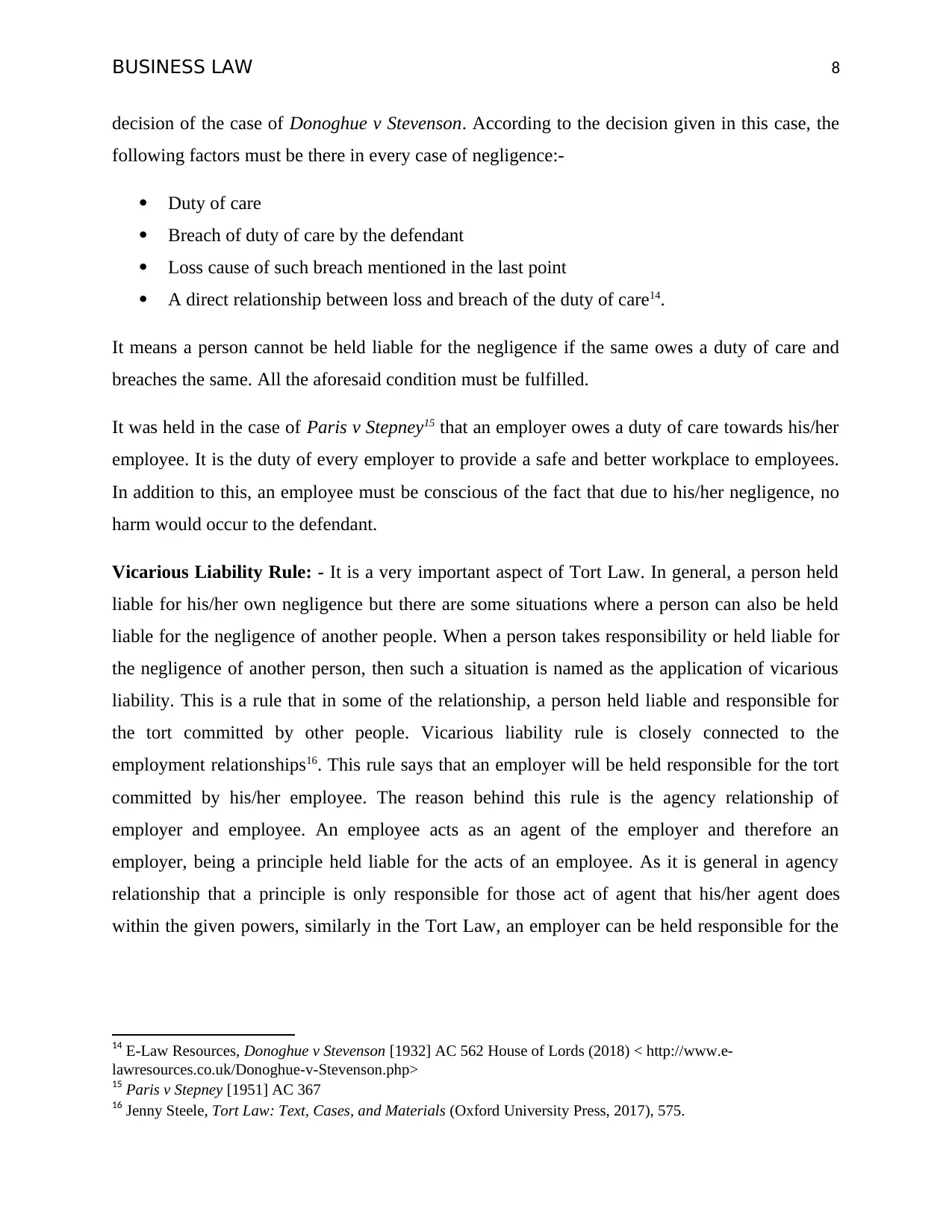
BUSINESS LAW 8
decision of the case of Donoghue v Stevenson. According to the decision given in this case, the
following factors must be there in every case of negligence:-
Duty of care
Breach of duty of care by the defendant
Loss cause of such breach mentioned in the last point
A direct relationship between loss and breach of the duty of care14.
It means a person cannot be held liable for the negligence if the same owes a duty of care and
breaches the same. All the aforesaid condition must be fulfilled.
It was held in the case of Paris v Stepney15 that an employer owes a duty of care towards his/her
employee. It is the duty of every employer to provide a safe and better workplace to employees.
In addition to this, an employee must be conscious of the fact that due to his/her negligence, no
harm would occur to the defendant.
Vicarious Liability Rule: - It is a very important aspect of Tort Law. In general, a person held
liable for his/her own negligence but there are some situations where a person can also be held
liable for the negligence of another people. When a person takes responsibility or held liable for
the negligence of another person, then such a situation is named as the application of vicarious
liability. This is a rule that in some of the relationship, a person held liable and responsible for
the tort committed by other people. Vicarious liability rule is closely connected to the
employment relationships16. This rule says that an employer will be held responsible for the tort
committed by his/her employee. The reason behind this rule is the agency relationship of
employer and employee. An employee acts as an agent of the employer and therefore an
employer, being a principle held liable for the acts of an employee. As it is general in agency
relationship that a principle is only responsible for those act of agent that his/her agent does
within the given powers, similarly in the Tort Law, an employer can be held responsible for the
14 E-Law Resources, Donoghue v Stevenson [1932] AC 562 House of Lords (2018) < http://www.e-
lawresources.co.uk/Donoghue-v-Stevenson.php>
15 Paris v Stepney [1951] AC 367
16 Jenny Steele, Tort Law: Text, Cases, and Materials (Oxford University Press, 2017), 575.
decision of the case of Donoghue v Stevenson. According to the decision given in this case, the
following factors must be there in every case of negligence:-
Duty of care
Breach of duty of care by the defendant
Loss cause of such breach mentioned in the last point
A direct relationship between loss and breach of the duty of care14.
It means a person cannot be held liable for the negligence if the same owes a duty of care and
breaches the same. All the aforesaid condition must be fulfilled.
It was held in the case of Paris v Stepney15 that an employer owes a duty of care towards his/her
employee. It is the duty of every employer to provide a safe and better workplace to employees.
In addition to this, an employee must be conscious of the fact that due to his/her negligence, no
harm would occur to the defendant.
Vicarious Liability Rule: - It is a very important aspect of Tort Law. In general, a person held
liable for his/her own negligence but there are some situations where a person can also be held
liable for the negligence of another people. When a person takes responsibility or held liable for
the negligence of another person, then such a situation is named as the application of vicarious
liability. This is a rule that in some of the relationship, a person held liable and responsible for
the tort committed by other people. Vicarious liability rule is closely connected to the
employment relationships16. This rule says that an employer will be held responsible for the tort
committed by his/her employee. The reason behind this rule is the agency relationship of
employer and employee. An employee acts as an agent of the employer and therefore an
employer, being a principle held liable for the acts of an employee. As it is general in agency
relationship that a principle is only responsible for those act of agent that his/her agent does
within the given powers, similarly in the Tort Law, an employer can be held responsible for the
14 E-Law Resources, Donoghue v Stevenson [1932] AC 562 House of Lords (2018) < http://www.e-
lawresources.co.uk/Donoghue-v-Stevenson.php>
15 Paris v Stepney [1951] AC 367
16 Jenny Steele, Tort Law: Text, Cases, and Materials (Oxford University Press, 2017), 575.
⊘ This is a preview!⊘
Do you want full access?
Subscribe today to unlock all pages.

Trusted by 1+ million students worldwide
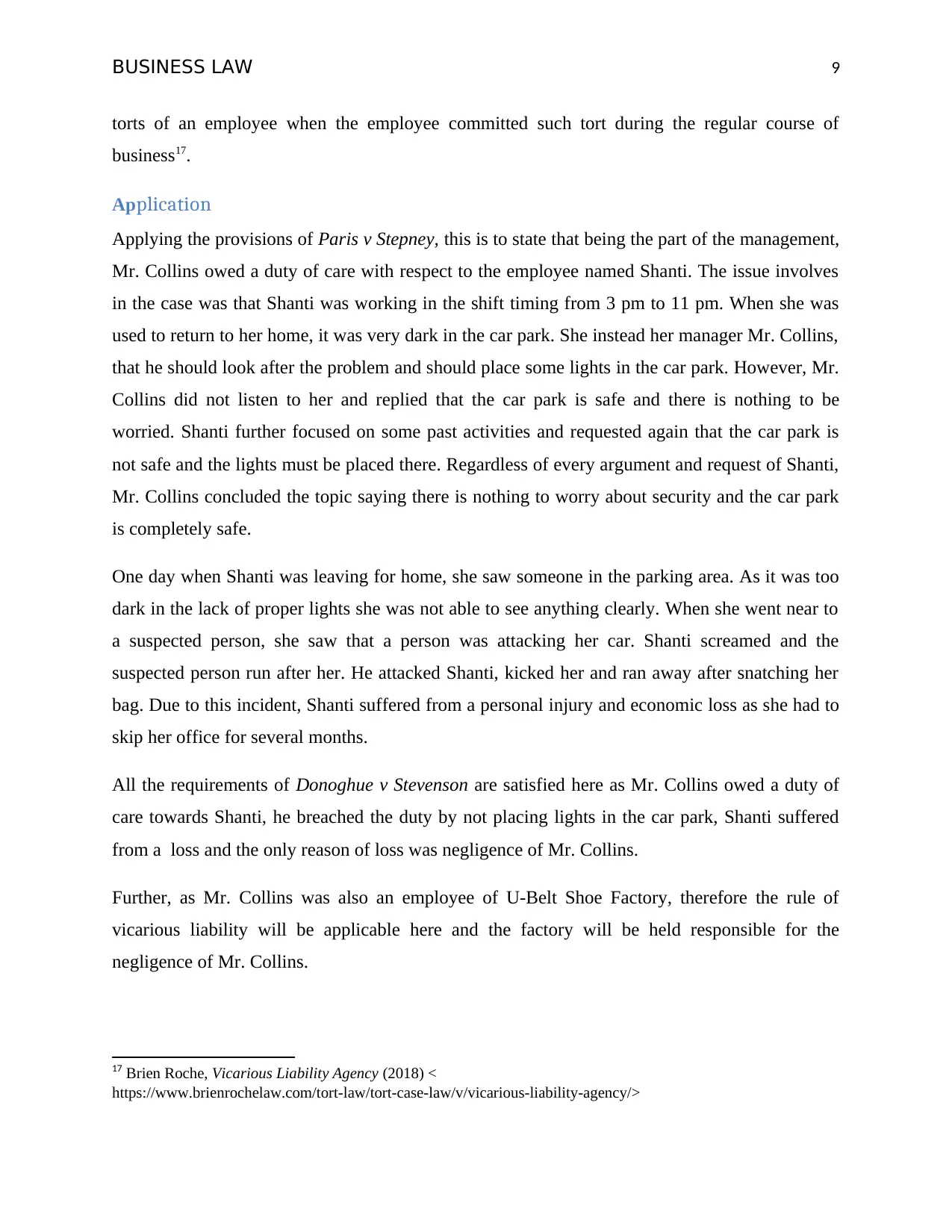
BUSINESS LAW 9
torts of an employee when the employee committed such tort during the regular course of
business17.
Application
Applying the provisions of Paris v Stepney, this is to state that being the part of the management,
Mr. Collins owed a duty of care with respect to the employee named Shanti. The issue involves
in the case was that Shanti was working in the shift timing from 3 pm to 11 pm. When she was
used to return to her home, it was very dark in the car park. She instead her manager Mr. Collins,
that he should look after the problem and should place some lights in the car park. However, Mr.
Collins did not listen to her and replied that the car park is safe and there is nothing to be
worried. Shanti further focused on some past activities and requested again that the car park is
not safe and the lights must be placed there. Regardless of every argument and request of Shanti,
Mr. Collins concluded the topic saying there is nothing to worry about security and the car park
is completely safe.
One day when Shanti was leaving for home, she saw someone in the parking area. As it was too
dark in the lack of proper lights she was not able to see anything clearly. When she went near to
a suspected person, she saw that a person was attacking her car. Shanti screamed and the
suspected person run after her. He attacked Shanti, kicked her and ran away after snatching her
bag. Due to this incident, Shanti suffered from a personal injury and economic loss as she had to
skip her office for several months.
All the requirements of Donoghue v Stevenson are satisfied here as Mr. Collins owed a duty of
care towards Shanti, he breached the duty by not placing lights in the car park, Shanti suffered
from a loss and the only reason of loss was negligence of Mr. Collins.
Further, as Mr. Collins was also an employee of U-Belt Shoe Factory, therefore the rule of
vicarious liability will be applicable here and the factory will be held responsible for the
negligence of Mr. Collins.
17 Brien Roche, Vicarious Liability Agency (2018) <
https://www.brienrochelaw.com/tort-law/tort-case-law/v/vicarious-liability-agency/>
torts of an employee when the employee committed such tort during the regular course of
business17.
Application
Applying the provisions of Paris v Stepney, this is to state that being the part of the management,
Mr. Collins owed a duty of care with respect to the employee named Shanti. The issue involves
in the case was that Shanti was working in the shift timing from 3 pm to 11 pm. When she was
used to return to her home, it was very dark in the car park. She instead her manager Mr. Collins,
that he should look after the problem and should place some lights in the car park. However, Mr.
Collins did not listen to her and replied that the car park is safe and there is nothing to be
worried. Shanti further focused on some past activities and requested again that the car park is
not safe and the lights must be placed there. Regardless of every argument and request of Shanti,
Mr. Collins concluded the topic saying there is nothing to worry about security and the car park
is completely safe.
One day when Shanti was leaving for home, she saw someone in the parking area. As it was too
dark in the lack of proper lights she was not able to see anything clearly. When she went near to
a suspected person, she saw that a person was attacking her car. Shanti screamed and the
suspected person run after her. He attacked Shanti, kicked her and ran away after snatching her
bag. Due to this incident, Shanti suffered from a personal injury and economic loss as she had to
skip her office for several months.
All the requirements of Donoghue v Stevenson are satisfied here as Mr. Collins owed a duty of
care towards Shanti, he breached the duty by not placing lights in the car park, Shanti suffered
from a loss and the only reason of loss was negligence of Mr. Collins.
Further, as Mr. Collins was also an employee of U-Belt Shoe Factory, therefore the rule of
vicarious liability will be applicable here and the factory will be held responsible for the
negligence of Mr. Collins.
17 Brien Roche, Vicarious Liability Agency (2018) <
https://www.brienrochelaw.com/tort-law/tort-case-law/v/vicarious-liability-agency/>
Paraphrase This Document
Need a fresh take? Get an instant paraphrase of this document with our AI Paraphraser
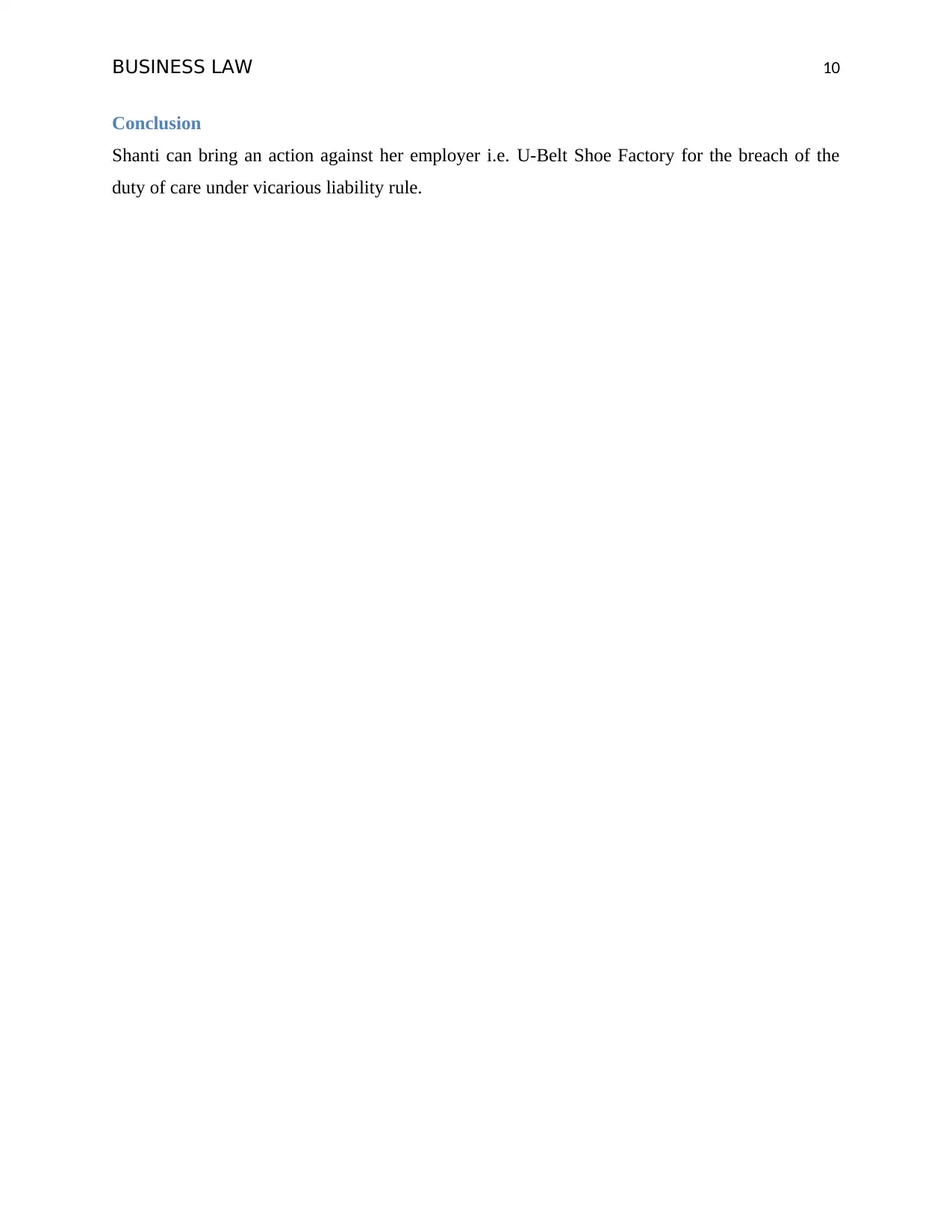
BUSINESS LAW 10
Conclusion
Shanti can bring an action against her employer i.e. U-Belt Shoe Factory for the breach of the
duty of care under vicarious liability rule.
Conclusion
Shanti can bring an action against her employer i.e. U-Belt Shoe Factory for the breach of the
duty of care under vicarious liability rule.
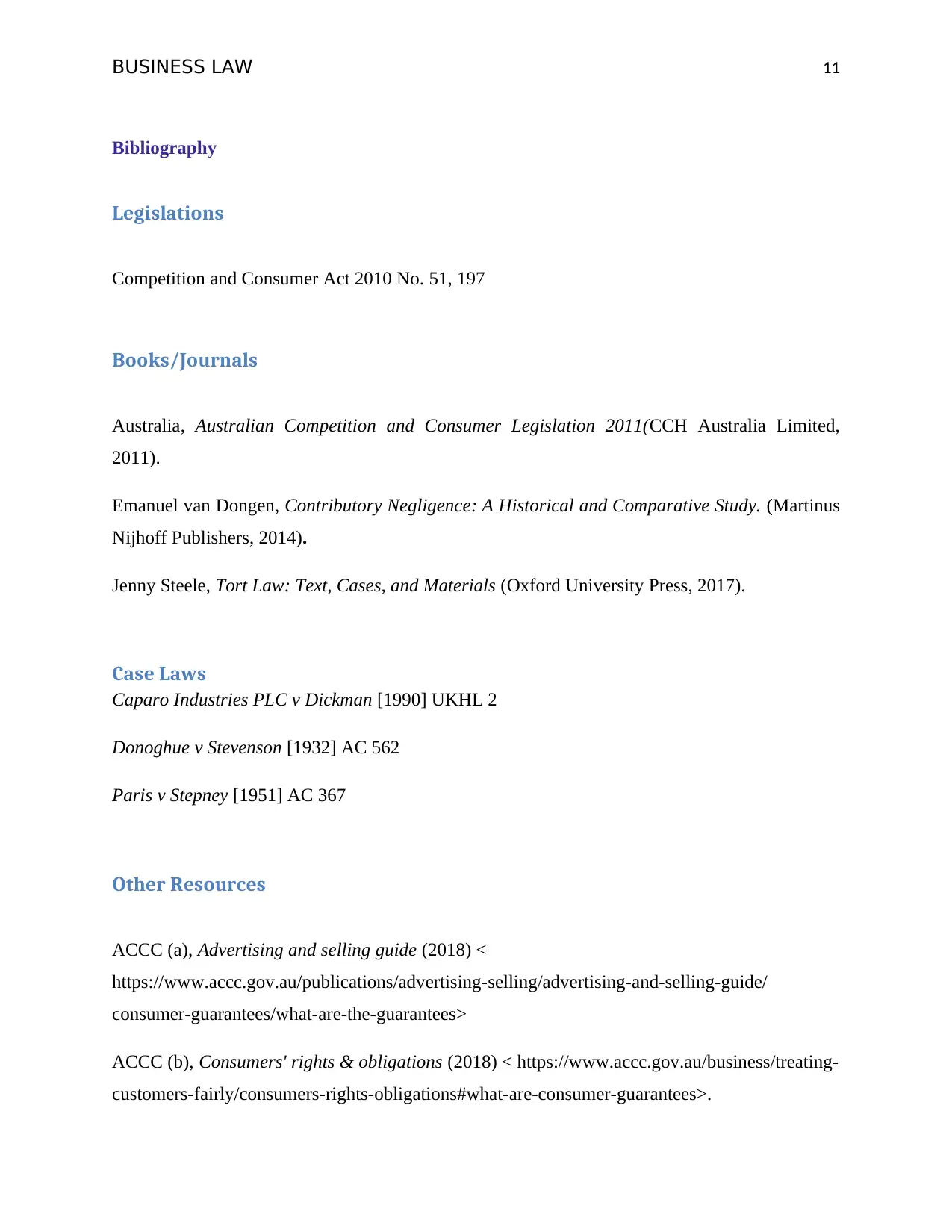
BUSINESS LAW 11
Bibliography
Legislations
Competition and Consumer Act 2010 No. 51, 197
Books/Journals
Australia, Australian Competition and Consumer Legislation 2011(CCH Australia Limited,
2011).
Emanuel van Dongen, Contributory Negligence: A Historical and Comparative Study. (Martinus
Nijhoff Publishers, 2014).
Jenny Steele, Tort Law: Text, Cases, and Materials (Oxford University Press, 2017).
Case Laws
Caparo Industries PLC v Dickman [1990] UKHL 2
Donoghue v Stevenson [1932] AC 562
Paris v Stepney [1951] AC 367
Other Resources
ACCC (a), Advertising and selling guide (2018) <
https://www.accc.gov.au/publications/advertising-selling/advertising-and-selling-guide/
consumer-guarantees/what-are-the-guarantees>
ACCC (b), Consumers' rights & obligations (2018) < https://www.accc.gov.au/business/treating-
customers-fairly/consumers-rights-obligations#what-are-consumer-guarantees>.
Bibliography
Legislations
Competition and Consumer Act 2010 No. 51, 197
Books/Journals
Australia, Australian Competition and Consumer Legislation 2011(CCH Australia Limited,
2011).
Emanuel van Dongen, Contributory Negligence: A Historical and Comparative Study. (Martinus
Nijhoff Publishers, 2014).
Jenny Steele, Tort Law: Text, Cases, and Materials (Oxford University Press, 2017).
Case Laws
Caparo Industries PLC v Dickman [1990] UKHL 2
Donoghue v Stevenson [1932] AC 562
Paris v Stepney [1951] AC 367
Other Resources
ACCC (a), Advertising and selling guide (2018) <
https://www.accc.gov.au/publications/advertising-selling/advertising-and-selling-guide/
consumer-guarantees/what-are-the-guarantees>
ACCC (b), Consumers' rights & obligations (2018) < https://www.accc.gov.au/business/treating-
customers-fairly/consumers-rights-obligations#what-are-consumer-guarantees>.
⊘ This is a preview!⊘
Do you want full access?
Subscribe today to unlock all pages.

Trusted by 1+ million students worldwide
1 out of 13
Related Documents
Your All-in-One AI-Powered Toolkit for Academic Success.
+13062052269
info@desklib.com
Available 24*7 on WhatsApp / Email
![[object Object]](/_next/static/media/star-bottom.7253800d.svg)
Unlock your academic potential
Copyright © 2020–2025 A2Z Services. All Rights Reserved. Developed and managed by ZUCOL.




